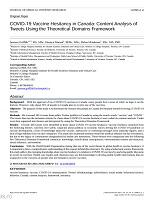Monkman, Helen
Person Preferred Name
Helen Monkman
Related Works
Content type
Digital Document
Abstract
Over the last decade, there has been an increase in the number of health care consumers (ie, patients, citizens, and laypeople) with access to their laboratory results through portals. However, many portals are not designed with the consumer in mind, which can limit communication effectiveness and consumer empowerment. We aimed to study design facilitators and barriers affecting consumer use of a laboratory results portal. We sought to identify modifiable design attributes to inform future interface specifications and improve patient safety. A web-based questionnaire with open- and closed-ended items was distributed to consumers in British Columbia, Canada. Open-ended items with affinity diagramming and closed-ended questions with descriptive statistics were analyzed.
Participants (N=30) preferred reviewing their laboratory results through portals rather than waiting to see their provider. However, respondents were critical of the interface design (ie, interface usability, information completeness, and display clarity). Scores suggest there are display issues impacting communication that require urgent attention. There are modifiable usability, content, and display issues associated with laboratory results portals that, if addressed, could arguably improve communication effectiveness, patient empowerment, and health care safety.
Origin Information
Content type
Digital Document
Abstract
<p>Presented at the <a href="https://mie2022.org/">Medical Informatics Europe (MIE) Conference</a>, Nice, France (May 27-30, 2022).</p>
<p>Laboratory (lab) test results are increasingly available online for patient review. However, there is a dearth of research with respect to users’ information needs, goals, and information processing strategies. In this exploratory qualitative study, we interviewed a sample of (N = 25) online lab results users to understand their objectives and search targets. We transcribed their responses and used affinity diagramming to identify themes in their responses. Our analysis identified six reasons why people look at their online lab results (i.e., health status, reassurance, health education, speed, self-management, and patient safety) and two themes about what people look for (i.e., abnormal and normal values, trends). Knowing what drives users and what information they are looking for can inform the design of online lab reporting, improve usefulness, and better satisfy user needs.</p>
Origin Information
Content type
Digital Document
Abstract
Background: With the approval of two COVID-19 vaccines in Canada, many people feel a sense of relief, as hope is on the horizon. However, only about 75% of people in Canada plan to receive one of the vaccines. The purpose of this study is to determine the reasons why people in Canada feel hesitant toward receiving a COVID-19 vaccine. Methods: We screened 3915 tweets from public Twitter profiles in Canada by using the search words “vaccine” and “COVID.” The tweets that met the inclusion criteria (i.e., those about COVID-19 vaccine hesitancy) were coded via content analysis. Codes were then organized into themes and interpreted by using the Theoretical Domains Framework. Results: Overall, 605 tweets were identified as those about COVID-19 vaccine hesitancy. Vaccine hesitancy stemmed from the following themes: concerns over safety, suspicion about political or economic forces driving the COVID-19 pandemic or vaccine development, a lack of knowledge about the vaccine, antivaccine or confusing messages from authority figures, and a lack of legal liability from vaccine companies. This study also examined mistrust toward the medical industry not due to hesitancy, but due to the legacy of communities marginalized by health care institutions. These themes were categorized into the following five Theoretical Domains Framework constructs: knowledge, beliefs about consequences, environmental context and resources, social influence, and emotion.
Conclusions
With the World Health Organization stating that one of the worst threats to global health is vaccine hesitancy, it is important to have a comprehensive understanding of the reasons behind this reluctance. By using a behavioral science framework, this study adds to the emerging knowledge about vaccine hesitancy in relation to COVID-19 vaccines by analyzing public discourse in tweets in real time. Health care leaders and clinicians may use this knowledge to develop public health interventions that are responsive to the concerns of people who are hesitant to receive vaccines.
Origin Information



